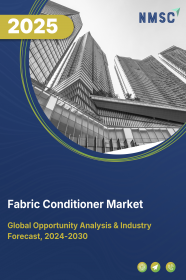
Fabric Conditioner Market by Form (Liquid, Powder, Dryer sheet, Capsule, Capsule / Pod, Beads / Crystals, Sprays, and Sachets), by Product Type (Conventional, Eco-friendly / Organic, and Specialty), by Distribution Channel (Offline, and Online), by Price Tier (Value, Mid-range, and Premium), and by End-User (Residential, Commercial, and Others) – Global Opportunity Analysis and Industry Forecast 2022-2030
Market Definition
The global Fabric Conditioner Market size was valued at USD 15 billion in 2022 and is predicted to reach USD 21 billion by 2030 with a CAGR of 4.3% from 2023-2030. Fabric conditioners also known as fabric softeners, are chemical substances used for laundry to maintain the natural softness and elasticity of the clothes with long-lasting fragrance. Fabric conditioners help prevent damage occurring in clothes by washing machines on fabrics such as cotton and wool.
The ingredients present in these fabric conditioners are positively charged long-chain molecules that bind with negatively charged fabric surfaces to nullify static cling. These conditioners fix the squashed, frayed threads that emerged on the surface of the fabric through the presence of active molecules compound in the ingredient. Essentially, fabric conditioner contains three key elements such as quaternary ammonium, emulsifier, conditioning agents, fragrance & colour along with stabilizers and preservatives to extend its shelf life.
Market Dynamics and Trends
Increasing demand for fabric conditioners the due to rapidly booming textile industry to improve the texture of the clothes has created a positive drive for the market across the globe. Additionally, the increasing number of working women leading to total household income growth and overall disposable income of growing middle-class consumers is also a factor for increasing demands of such products. The growing trend towards adopting a minimalistic lifestyle leads to prolonged usage of clothes leading to the value sustained number of washes.
Furthermore, the rise in various types of special fabric conditioners in the market including anionic softeners, amphoteric softeners, and polyethylene-based softeners provides better quality and stability to the clothes. The properties of alkali present in polyethylene-based softeners provide higher quality and more stability to the fabric, which in turn boost the growth of this market. The growing innovation by companies such as pre-added detergent that acts both as fabric cleaners and conditioners that save time and money for the consumers, propels the growth of this market.
For instance, in April 2021, Godrej Consumer Products Limited (GCPL) expanded its laundry detergent portfolio with the launch of Godrej Ezee’s 2-in-1 liquid detergent and fabric conditioner. It is intended to offer a first-of-its-kind product in the category that combines two formats into one. And it is easy to use for both buckets as well as machine wash. Furthermore, the easy availability of fabric conditioners to the nearest convenience store paired with the availability of a wide range of products with heavy discounts acts as a driver for this market.
However, negative impacts on the environment due to the presence of artificial and toxic chemicals that tend to pollute water are the factors restraining the growth of the market during the forecast period. On the contrary, rising demand and awareness for eco-friendly fabric softeners, such as Ecover Fabric Softener, Soganics Eco-Friendly Fabric Softener and Method Liquid Fabric Softener are expected to create ample growth opportunities for the market in the coming years.
Market Segmentations and Scope of the Study
The fabric conditioner market report is segmented on the basis of form, application, distribution channel, end-users, and geography. On the basis of form, the market is divided into liquid, powder, dryer sheet, capsule, crystal, beads, sprays, and sachets. On the basis of application, the market is divided into household, hospitality, and others. On the basis of distribution channel, the market is divided into supermarkets, hypermarkets, departmental stores, online, and others. On the basis of end-users, the market is divided into commercial, residential, and others. Geographic breakdown and analysis of each of the aforesaid segments include regions comprising of North America, Europe, Asia-Pacific, and RoW.
Geographical Analysis
North America holds the lion’s share of the fabric conditioner market size during the forecast period. This is attributed to factors such as increasing online sales through e-commerce that push the demand for both washing machines along with fabric conditioners. For instance, in 2020, total US e-commerce sales reached 960.1 billion USD, which is an 18.3% year-over-year increase from 811.6 billion USD. Also, the rapid revival of laundry services that include self-service laundry, coin laundry and laundromat along with the uses of downy fabric softener that can make clothes look newer and last long, reducing the static caused by washing and drying clothes thus, boosting the market growth in the region.
On the other hand, Asia-Pacific is expected to show a steady rise in the market due to the increasing number of working women and the rise in sales penetration through retail and e-commerce channels such as Alibaba and Flipkart.Also, the development of innovative products targeting biodegradability and skin-friendliness.
For instance, in December 2021, Cosmo Speciality Chemicals launched Hanatex Soft range, which is a highly concentrated speciality silicone softener that gives inner softness and surface smoothness. It is based on speciality amino silicone that improves the stretch and recovery capacity of Knit goods. Moreover, the growing demand for new types of fabrics such as cashmere and washable wool, which are made from modern synthetic fibres that need special care and treatment to sustain their unique properties such as smoothness and elasticity drives the market growth in this region.
Competitive Landscape
The fabric conditioner industry comprising of various market players such as Procter & Gamble Co. (Downy), Unilever PLC (Comfort), Henkel AG & Co. KGaA (Snuggle), S. C. Johnson & Son, Inc. (Ecover), Kao Corporation, Colgate-Palmolive Company, Reckitt Benckiser, Church & Dwight, LG Household & Health Care Ltd., The Clorox Company, Shanghai Hutchison Whitecat Co., Ltd., Godrej Consumer Products, Werner & Mertz, Lion Corporation, Pigeon Corporation, Nice Group Co., Ltd., Ecolab Inc., Diversey, Inc., Melaleuca, Inc., Norfil Inc. These market players are adopting various strategies such as joint venture strategies and planning expansion of business across various regions to maintain their dominance in the market.
For instance, in March 2025, Procter & Gamble Co. (Downy) partnered with Operation Warm, contributing $100,000 toward providing winter coats, shoes, and books to underserved children in Tennessee and Ohio. Events took place at local schools, in collaboration with Dollar General. Moreover, in May 2025, Unilever PLC (Comfort) introduced the Pure Heaven Scent regime—encompassing Persil detergent, Comfort fabric conditioner, and scent boosters—targeted at consumers with sensitive skin. The launch included an influencer-led campaign featuring Molly-Mae Hague.
Key Benefits
-
The fabric conditioner market report provides the quantitative analysis of the current market and estimations through 2022-2030 that assist in identifying the prevailing market opportunities to capitalize on.
-
The study comprises a deep dive analysis of the fabric conditioner market trend including the current and future trends for depicting the prevalent investment pockets in the market.
-
The information related to key drivers, restraints and opportunities and their impact on the fabric conditioner market is provided in the report.
-
The competitive analysis of the market players along with their market share in the fabric conditioner market.
-
The SWOT analysis and Porter’s Five Forces model are elaborated in the study.
-
Value chain analysis in the market study provides a clear picture of the stakeholders’ roles.
Key Market Segments
By Form
-
Liquid
-
Powder
-
Dryer Sheet
-
Capsule / Pod
-
Beads / Crystals
-
Spray
-
Sachet
By Product Type
-
Conventional
-
Eco-friendly / Organic
-
Specialty
By Distribution Channel
-
Offline
-
Supermarkets
-
Hypermarkets
-
Department Stores
-
-
Online
By Price Tier
-
Value
-
Mid-range
-
Premium
By End-User
-
Residential
-
Commercial
-
Others
By Geography
-
North America
-
The U.S.
-
Canada
-
Mexico
-
-
Europe
-
The U.K.
-
Germany
-
France
-
Italy
-
Spain
-
Denmark
-
Netherlands
-
Finland
-
Sweden
-
Norway
-
Russia
-
Rest of Europe
-
-
Asia-Pacific
-
China
-
Japan
-
India
-
South Korea
-
Australia
-
Indonesia
-
Singapore
-
Taiwan
-
Thailand
-
Rest of Asia-Pacific
-
-
RoW
-
Latin America
-
Middle East
-
Africa
-
Key Players
-
Procter & Gamble Co. (Downy)
-
Unilever PLC (Comfort)
-
Henkel AG & Co. KGaA (Snuggle)
-
S. C. Johnson & Son, Inc. (Ecover)
-
Kao Corporation
-
Colgate-Palmolive Company
-
Reckitt Benckiser
-
Church & Dwight
-
LG Household & Health Care Ltd.
-
The Clorox Company
-
Shanghai Hutchison Whitecat Co., Ltd.
-
Godrej Consumer Products
-
Werner & Mertz
-
Lion Corporation
-
Pigeon Corporation
-
Nice Group Co., Ltd.
-
Ecolab Inc.
-
Diversey, Inc.
-
Melaleuca, Inc.
-
Norfil Inc.

















 Speak to Our Analyst
Speak to Our Analyst





















